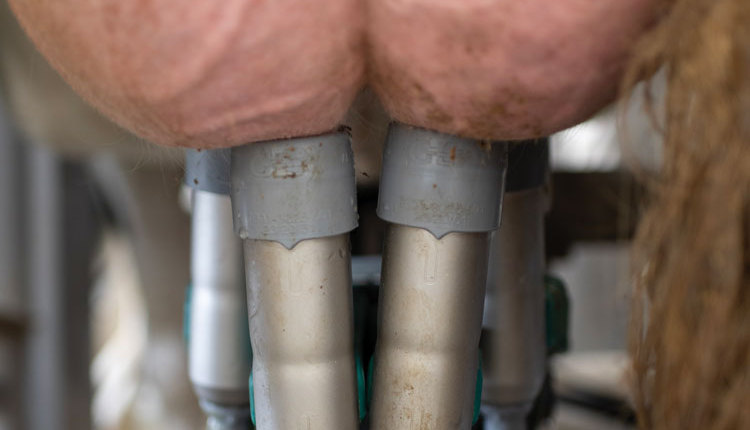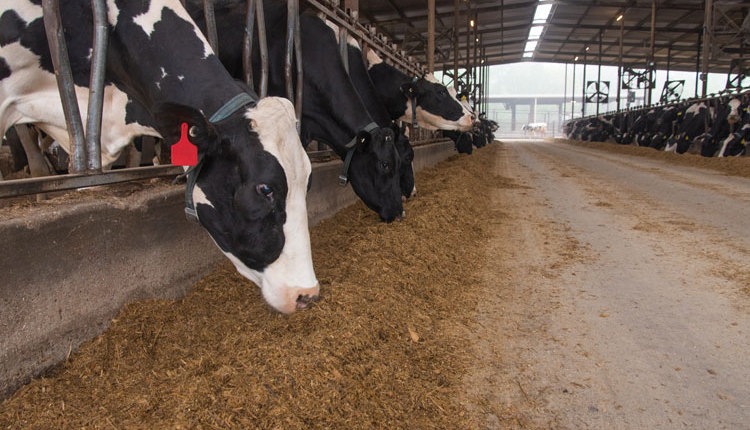
In 1924, the U.S. dairy herd consisted of approximately 21 million cows, each producing around 4,167 pounds of milk annually. At the time, the average cow consumed about 21.4 pounds of dry matter (DM) daily. Advancements in genetics, nutrition, and management have led to a dramatic improvement in intake, productivity, and efficiency today.
The U.S. dairy herd now has 9.36 million cows — a 55% reduction in herd size from 1924. Each cow produces, on average, 24,200 pounds of milk annually and eats approximately 60 pounds of dry matter (DM) daily. This shift has resulted in a three-fold bump in feed efficiency, as modern dairy cows produce significantly more milk from each pound of feed.
Despite this rise in individual productivity and intake, total methane emissions have declined since 1924 due to the reduction in herd size and greater feed efficiency. This underscores the environmental progress achieved in dairy production as the industry produces more milk with fewer cows and less total methane emissions.
A closer look
We used the Ellis Model, a common tool in agricultural and environmental studies, to estimate daily methane emissions for dairy cows in both 1924 and 2024 based on their dry matter intake (DMI). The model uses total feed intake to estimate methane output in megajoules (MJ) per day. Methane is measured in megajoules to reflect its energy content, as each kilogram of methane contains approximately 55.5 MJ.
This measurement is useful for several reasons. First, it enables consistent comparisons across different energy sources, such as fossil fuels, making it easier to integrate methane emissions into broader energy and environmental analyses.
Second, in livestock nutrition, it represents the energy lost as methane, which is important for assessing feed efficiency. By measuring methane in MJ, researchers can quantify how much feed energy is not utilized by the animal but instead released as methane. Lastly, using MJ aligns with greenhouse gas reporting standards, allowing methane emissions to be easily converted into carbon dioxide equivalents (CO2e) for standardized reporting.
The methane emissions estimate of 11.32 MJ per day (or 74.46 kg per year) provides a reasonable approximation for modern dairy cows, though it is somewhat lower than current estimates of 100 to 130 kilograms per year (or 273 to 356 grams per day). This difference likely stems from the Ellis Model relying solely on DMI without accounting for diet composition (for example, forage versus concentrate ratios), which can influence methane production.
High-yielding cows on energy-dense diets may emit more methane than the model predicts. Nevertheless, since the same model was used for 1924 and 2024, the comparison remains valid, allowing for reliable assessment of changes in emissions over the past century.
Crunching the numbers
Despite the rise in individual methane emissions in modern cows due to their greater feed intake, the total emissions have dropped substantially since 1924. This change is primarily due to a reduction in the cow population — from 21 million in 1924 to 9.36 million in 2024. Consequently, the total emissions can be estimated to be around 106 million MJ per day (9.36 million cows × 11.32 MJ), compared to 126 million MJ per day for cows from 1924 (21 million cows × 6.00 MJ). This represents a 16% decrease in total methane emissions.
Methane intensity measures the amount of methane emitted per unit of milk produced, reflecting emissions efficiency relative to productivity. In 1924, methane intensity was approximately 1.16 MJ per kg of milk, with each cow producing 4,167 pounds of milk annually. By 2024, methane intensity dropped to 0.38 MJ per kg of milk as cows now produce 24,200 pounds of milk per year. This decline in methane intensity highlights improvements in feed efficiency and productivity, resulting in lower emissions per unit of milk. While total emissions have fallen by 16%, methane intensity (emissions per unit of milk) has improved by approximately 67.2%, indicating much higher productivity efficiency relative to emissions over the century.
This allows us to examine both the growth in productivity per cow and the overall environmental impact of the dairy industry, highlighting how changes in herd size and productivity have contributed to a reduction in methane emissions from dairy over the last century. With advancements in genetics, nutrition, and management, today’s dairy industry has achieved significant environmental improvements. The analysis suggests that today’s dairy cows are much more efficient, producing substantially more milk with lower total methane emissions than a century ago.
This article appeared in the February 2025 issue of Journal of Nutrient Management on pages 10-11. Not a subscriber? Click to get the print magazine.






